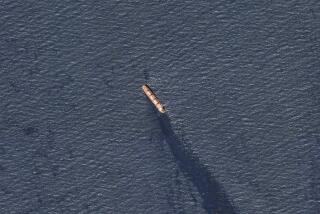Great Barrier Reef rammed by Chinese coal ship
- Share via
Reporting from Seoul Kenneth R. Weiss and Los Angeles -- Australians on Sunday scrambled to ensure that a Chinese-owned bulk coal carrier that rammed into the Great Barrier Reef would not break apart and seriously damage the planet’s largest coral reef.
Peter Garrett, the nation’s environment protection minister, told reporters that the government was concerned about the effect an oil spill could have on the environmentally sensitive reef, one of the wonders of the natural world that was selected as a World Heritage Site in 1981.
Environmentalists said they were horrified at the possible damage the accident might cause to the ecosystem, which is more than 1,200 miles long and comprises more than 3,000 individual reefs, cays and islands, providing a habitat for countless sea species.
Coral reefs cover slightly less than 1% of the world’s oceans, but are home to about 25% of all identified marine species.
Like other coral reefs, the Great Barrier Reef was built on the backs of small, colonial animals that make formations resembling tabletops, giant brains or elk horns. Growing on top of one another, these skeletons of calcium carbonate fuse together into rock that can slice through a ship’s hull like a can opener.
Besides physical damage to the reef, the greatest threat from the cargo vessel comes from the roughly 300,000 gallons of heavy fuel oil it carries to run its engines.
Shipping companies favor such low-grade fuel because it’s cheap. But it is also particularly viscous, almost like sludge, and needs to be heated before injected into engines. The gooey texture makes this class of fuel more ecologically troublesome and more difficult to clean up as it coats birds and other wildlife, corals and sandy beaches.
Video taken late Sunday showed the 700-plus-foot vessel stranded about nine miles outside the shipping lane, leaking what seemed to be a streak of oil into the Great Barrier Reef Marine Park near Great Keppel Island off the east coast of Queensland state.
Great Keppel Island, about 340 miles north of Brisbane, has long been a major tourist destination on the Great Barrier Reef, which provides Australia a great source of national pride and tourist dollars.
The government has moved to protect this national treasure in recent decades, setting aside about one-third as marine reserves off-limits to fishing and other forms of exploitation. Despite these underwater parks, the reef has suffered significant declines from a combination of overfishing, fertilizer runoff from land and coral bleaching from hot water associated with global warming.
Marine ecologists often talk about oil spills as the nightmare scenario that can push coral reefs or other undersea areas past the point from which they can recover, particularly when their resilience has been weakened by other chronic stress.
“Climate change is a problem for virtually all coral reefs, and fishing has had some problem there,” said Ben Halpern, a marine ecologist at UC Santa Barbara. “If you add into that a major oil spill, it tends to push the system past the tipping point.”
What happens beyond that point, Halpern said, is the subject of much study. What’s known is that corals tend to die. The reefs become overgrown with invasive algae. Then the fish and other marine life that rely on a living reef can no longer survive.
On Sunday, early-morning flights over the carrier identified a small number of oil patches about two nautical miles southeast from the vessel, according to a news release from the Queensland state government.
A light aircraft was also shown spraying a chemical dispersant on the spilled oil. Authorities said they planned to assess the success of the move before continuing with the spraying.
“This is a serious situation and we’ve mobilized air, sea and land resources in response,” Queensland Premier Anna Bligh said.
“The situation remains serious as the extent of the damage means that there is a very real risk that the vessel may break apart. Every effort is now being made to limit the impact of this incident.”
The Shen Neng 1, hauling more than 65,000 tons of coal, hit the reef at full speed late Saturday in a restricted zone of the marine park. The impact ruptured the vessel’s fuel tanks, prompting Australian officials to activate a national oil spill response plan.
The Australian Transport Safety Bureau will be conducting a full investigation of the incident. The carrier was aground on a shoal and is not expected to be moved without salvage assistance.
Authorities said late Sunday that they were trying to assess the scope of a salvage project.
Capricorn Conservation Council, a national environmental group, said in a release that it was “horrified that a Chinese coal carrier has run aground near Great Keppel Island.”
The group called for a marine pilot to be required for all vessels operating in the area.
“We can be certain that this is a sign of things to come,” spokesman Ian Herbert said.
“Who knows what damage will be done to our local coral reefs and marine animals from the oil spill from the ship. We are outraged that no marine pilot is required on ships between Gladstone and Cairns. This will increase the likelihood of similar events.”
Park is a researcher in The Times’ Seoul Bureau.
More to Read
Sign up for Essential California
The most important California stories and recommendations in your inbox every morning.
You may occasionally receive promotional content from the Los Angeles Times.










